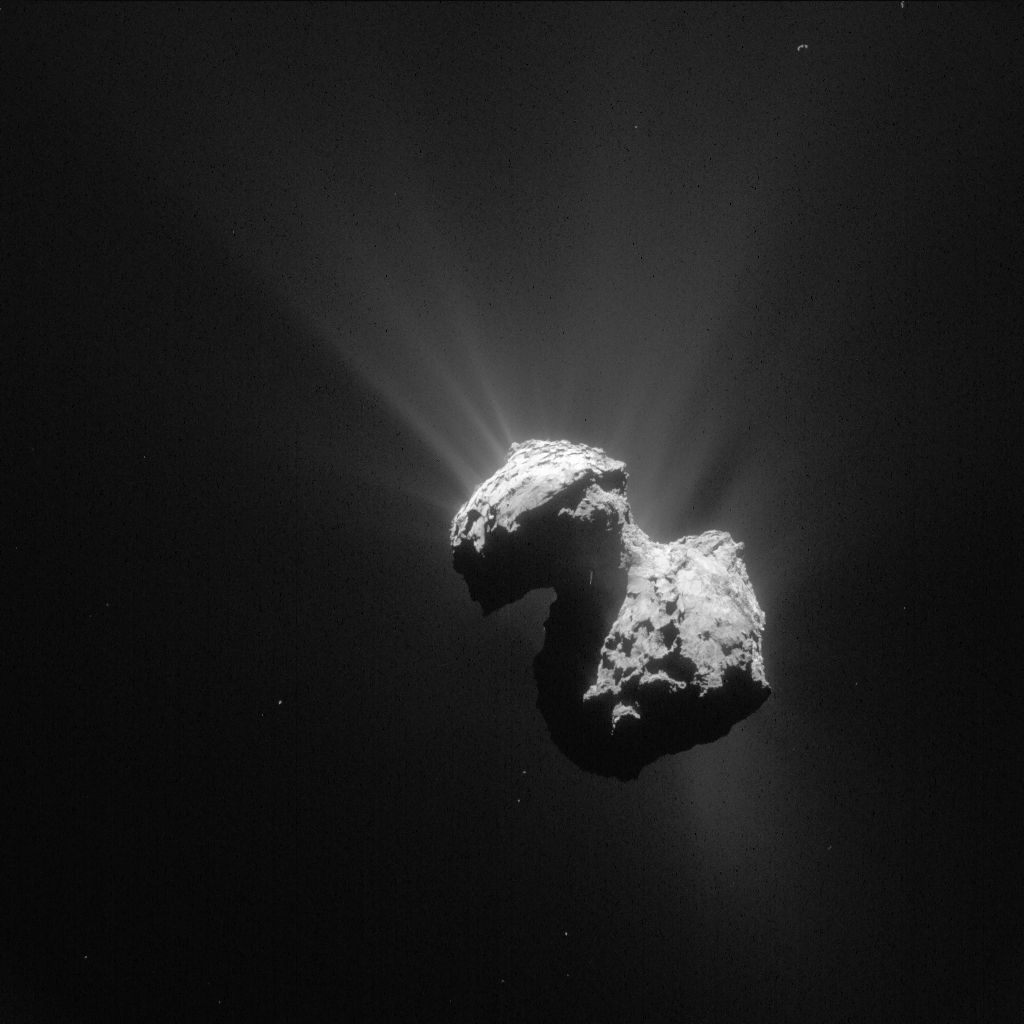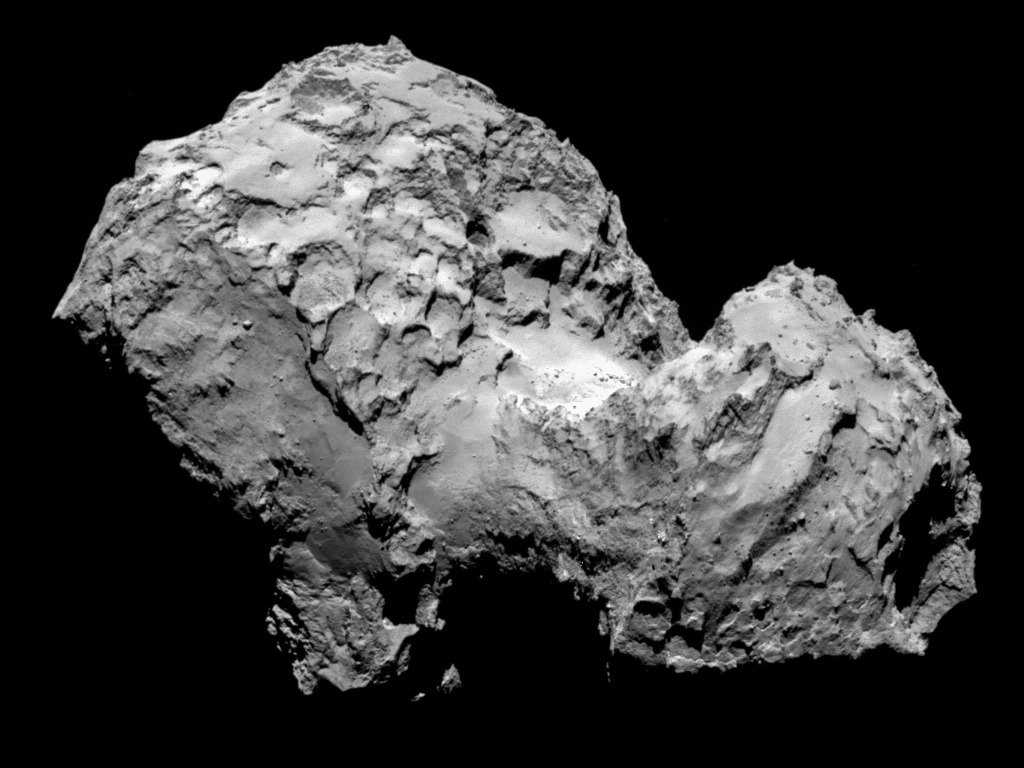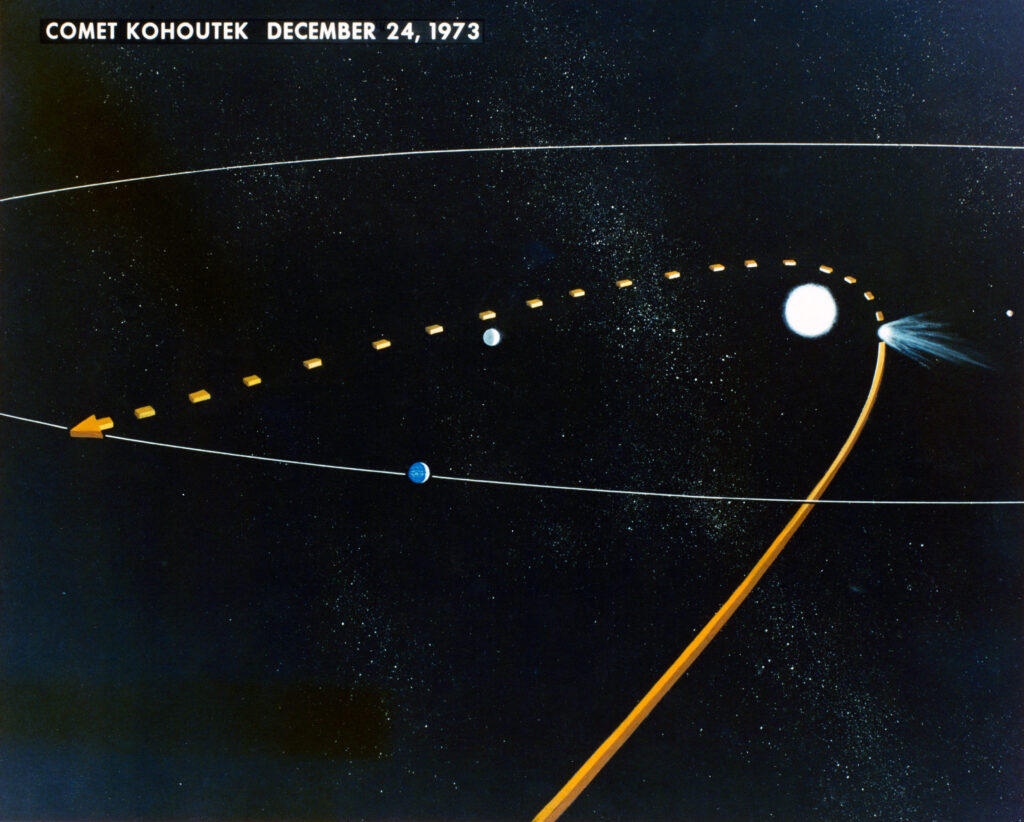Icy Nomads of the Solar System
© NASA/SOFIA/Lynette Cook
Comets are small, icy objects within the Solar System that undergoes heating and release gases as it approaches the Sun, a phenomenon known as outgassing. This process results in the formation of an extended, gravitationally unbound atmosphere or coma around the nucleus, often accompanied by a tail of gas and dust blown away from the coma. These occurrences are a consequence of the interaction between solar radiation, the outstreaming solar wind plasma, and the comet’s nucleus.
Comet nuclei vary in size, ranging from a few hundred meters to tens of kilometers in diameter, and are composed of loose aggregates of ice, dust, and small rocky particles. The coma can expand to up to 15 times the diameter of Earth, while the tail may extend beyond one astronomical unit. When a comet is sufficiently close and luminous, it may be visible from Earth without the need for a telescope, spanning an arc of up to 30° (equivalent to 60 Moons) across the sky.
Comets typically follow highly eccentric elliptical orbits, displaying a broad range of orbital periods that span from several years to potentially several millions of years. Short-period comets have their origins in the Kuiper belt or the associated scattered disc, situated beyond the orbit of Neptune. On the other hand, long-period comets are believed to originate in the Oort cloud, a spherical collection of icy bodies extending from beyond the Kuiper belt to halfway toward the nearest star. The gravitational influences of passing stars and the galactic tide set long-period comets in motion toward the Sun. In contrast, hyperbolic comets may traverse the inner Solar System once before being propelled into interstellar space.
The observation and documentation of comets date back to ancient times, with numerous cultures and religions noting these celestial phenomena. Comets, with their captivating tails and dynamic behaviours, continue to be a subject of fascination and scientific study in the exploration of our solar system.
CHARACTERISTICS AND DIVERSITY

Comets exhibit a fascinating array of characteristics and display significant diversity, contributing to their uniqueness within the celestial landscape.
ORBITAL CHARACTERISTICS
ECCENTRIC ORBITS
Comets are celestial wanderers that traverse the Solar System along highly eccentric orbits. Unlike the nearly circular orbits of planets, comets follow elongated paths, with eccentricities often approaching or exceeding 1. These eccentric orbits take comets on a journey from the frigid, distant reaches of the Solar System to close encounters with the Sun during their perihelion, the point of closest approach.
The eccentricity of a comet’s orbit contributes to its dynamic behaviour, impacting the speed and distance covered during different phases of its journey. As a comet approaches the Sun, the increasing solar radiation induces the sublimation of volatile ices within its nucleus, leading to the formation of a glowing coma and a distinctive tail. This phenomenon is most pronounced during perihelion, making the eccentricity of a comet’s orbit a crucial factor in determining the intensity of its interaction with the Sun.
VARIED ORBITAL PERIOD
Comets exhibit a remarkable diversity in their orbital periods, reflecting the vast range of distances they travel within the Solar System. The orbital period of a comet is the time it takes to complete one full revolution around the Sun. This characteristic varies widely among comets, offering insights into their origins and trajectories.
Short-period comets typically have orbital periods of several years to a few decades. Originating from regions like the Kuiper Belt or its associated scattered disc, these comets follow relatively swift and predictable paths, frequently returning to the inner Solar System.
In contrast, long-period comets have orbital periods that can extend from several decades to potentially millions of years. These comets are believed to originate from the distant Oort Cloud, a vast reservoir of icy bodies that lies far beyond the orbit of Pluto. Their infrequent appearances make long-period comets less predictable and more challenging to study.
COMPOSITION
ICY NUCLEUS
The icy nucleus of comets serves as the central core of these celestial bodies. Comprising a mixture of volatile ice, dust, and small rocky particles, the nucleus is the primary source of a comet’s activity and distinctive features. Varying in size and structure, comet nuclei undergo sublimation as they approach the Sun, leading to the formation of a glowing coma and a tail composed of released dust and gases. Space missions, such as NASA’s Stardust and ESA’s Rosetta, have provided close-up observations, enhancing our understanding of the composition and characteristics of these icy nuclei.
DUST AND GAS EMISSIONS
Comets exhibit distinctive features known as dust and gas emissions. As comets approach the Sun, volatile ices within their icy nuclei undergo sublimation, transitioning directly from solid to gas. This process releases dust and gases, forming a glowing coma (atmosphere) and often a tail that points away from the Sun. These emissions contribute to the visual spectacle of comets and provide valuable insights into the composition and behaviour of these celestial wanderers.
ORIGINS
KUIPER BELT AND SCATTERED DISC
Comets, with their origins rooted in the outer reaches of the solar system, find their source in regions known as the Kuiper Belt and the Scattered Disc. The Kuiper Belt, situated beyond the orbit of Neptune, is a vast region hosting a myriad of icy bodies, including dwarf planets and comets. Short-period comets, characterized by relatively brief orbital periods, are believed to originate in the Kuiper Belt and its associated Scattered Disc.
The Kuiper Belt is a reservoir of icy remnants from the early solar system, providing a glimpse into the conditions and materials that contributed to the formation of comets. As these icy bodies are perturbed by gravitational interactions or other celestial influences, some comets are set on trajectories that bring them closer to the Sun, resulting in their characteristic appearances with bright comas and tails during perihelion.
OORT CLOUD
The Oort Cloud, a vast and hypothetical region surrounding the outer reaches of the solar system, plays a pivotal role in the origin of comets. This distant and largely unexplored area is believed to be a reservoir of icy bodies, including comets, extending far beyond the Kuiper Belt. Comets with long orbital periods, known as long-period comets, are thought to originate from the Oort Cloud.
Comprising a spherical cloud of icy objects, the Oort Cloud is positioned at an immense distance from the Sun, ranging from a few thousand astronomical units (AU) to potentially halfway to the nearest star. Gravitational perturbations from passing stars or the galactic tide can disrupt the delicate equilibrium of these icy bodies, setting them on trajectories that bring them toward the inner solar system.
As long-period comets journey from the Oort Cloud, they become visible when they approach the Sun, showcasing their distinctive comas and tails during perihelion.
MOTION AND TRAJECTORY
GRAVITATIONAL PERTURBATIONS
Gravitational perturbations play a crucial role in shaping the trajectories of comets within the solar system. As comets follow their eccentric orbits, they are subject to gravitational influences from various celestial bodies, such as planets, passing stars, and the galactic tide.
These gravitational perturbations can lead to significant changes in a comet’s path, altering its orbital parameters and, in some cases, redirecting it on a new trajectory. Planets, with their relatively large masses, can exert gravitational forces that either accelerate or decelerate a comet, influencing its speed and altering the shape of its orbit.
Passing stars and the gravitational pull of the Milky Way‘s galactic tide can also disturb the delicate balance of a comet’s orbit. These external influences may result in comets being propelled toward the inner solar system, where they become visible as they approach the Sun.
HYPERBOLIC ORBITS
Comets with hyperbolic orbits follow a unique and distinct path within the solar system. Unlike the more common elliptical orbits that result in a periodic return to the Sun, hyperbolic orbits are characterized by trajectories that are open and unbounded. Comets on hyperbolic orbits typically approach the Sun only once before being flung out of the solar system entirely.
When a comet is on a hyperbolic trajectory, its eccentricity exceeds 1, leading to a shape resembling an open curve. This occurs when the comet’s speed is sufficiently high, allowing it to escape the gravitational influence of the Sun after its brief journey through the inner solar system. Hyperbolic comets may originate from the Oort Cloud, a distant reservoir of icy bodies, and their unique trajectories make them particularly interesting for scientific study.
VISIBILITY OF COMETS
The visibility is a captivating aspect of these celestial objects, capturing the attention of skywatchers and astronomers alike. A comet’s visibility is influenced by factors such as its distance from the Sun, its brightness, and its position in the sky. When a comet is closer to the Sun, it often becomes more visible as solar radiation causes the sublimation of volatile ices within its nucleus, leading to the formation of a glowing coma and a distinctive tail. The intrinsic brightness of a comet, known as its magnitude, also plays a significant role in determining how easily it can be observed from Earth. Bright comets may be visible to the naked eye, creating memorable celestial displays.
SURFACE FEATURES

Comets, with their icy nuclei and dynamic behaviour, exhibit a variety of surface features that provide valuable insights into their composition and evolutionary history. While detailed observations have been limited, space missions such as NASA’s Stardust and ESA’s Rosetta have provided close-up views of comet surfaces, revealing intriguing characteristics:
CRATERS AND DEPRESSIONS
Comets, celestial wanderers composed of volatile ices and dust, often bear witness to the impacts and interactions occurring within our solar system. One prominent manifestation of such events is the presence of craters and depressions on the surfaces of comets. These features, resembling pockmarks and indentations, are believed to result from the impact of smaller celestial bodies, such as meteoroids or fragments from disintegrating comets. The collisions create impressions on the comet’s surface, leaving behind a record of cosmic encounters.
JETS AND OUTBURSTS
Jets and outbursts are dynamic phenomena observed on the surfaces of comets, contributing to their captivating appearance. These events occur as a result of the sublimation of volatile ice within the comet’s nucleus when it approaches the Sun. The intense solar radiation causes the ice to transition directly from a solid to a gaseous state, creating jets of gas and dust that propel outward from active regions on the comet’s surface. These outbursts play a crucial role in the formation of the comet’s coma (atmosphere) and tail, adding to the celestial spectacle during its journey through the inner solar system.
PLAINS AND TERRAINS
Comets, with their intriguing icy nuclei, exhibit a variety of surface features, including plains and terrains. Some comets showcase relatively smooth plains and terrains on their surfaces, suggesting deposition processes or internal dynamics that have shaped these areas. These regions may be the result of material settling on the comet’s surface during its journey through the solar system or internal processes influencing its topography.
RIDGES AND CLIFFS
Ridges and cliffs on the surfaces of comets offer intriguing insights into the structural dynamics of these celestial bodies. These features may arise from a variety of factors, including internal forces, thermal stresses, or the sublimation of underlying ices. The rugged terrain formed by ridges and cliffs adds complexity to the comet’s landscape, providing evidence of the dynamic processes at play on its surface.
CERVICES AND FISSURES
Crevices and fissures adorn the surfaces of comets, revealing the intricate and evolving nature of these celestial wanderers. These features suggest a dynamic interplay of forces and processes, potentially influenced by sublimation, thermal stresses, and gravitational forces. Crevices, resembling deep cracks, and fissures, narrow openings, contribute to the overall ruggedness of the comet’s terrain. They provide scientists with valuable clues about the internal structure and ongoing changes on the comet’s surface as it traverses the solar system.
BOULDERS AND ROCKY OUTCROPS
Boulders and rocky outcrops pepper the surfaces of comets, contributing to their rugged and diverse terrains. These features, ranging in size from small rocks to larger outcrops, add an element of complexity to the comet’s landscape. The presence of boulders suggests the coexistence of rocky and icy materials on the comet’s surface. These formations may result from a combination of factors, including the deposition of material during the comet’s journey through the solar system or internal processes that have shaped its topography.
Observations from space missions have revealed that comet surfaces can change over time. Sublimation, erosion, and other processes may continuously modify the comet’s appearance as it journeys through the solar system.
ORBITAL DYNAMICS

The orbital dynamics of comets are intricately tied to the gravitational forces and interactions within the solar system. Comets typically follow elliptical orbits, varying widely in shape and size, and their trajectories are influenced by the gravitational pull of the Sun and other celestial bodies.
- Eccentric Orbits: Comets are characterized by highly eccentric orbits, with elongated shapes that bring them from the outer reaches of the solar system to close proximity to the Sun during perihelion, the point of closest approach.
- Origins in Distant Regions: Short-period comets, which have orbital periods of a few years, often originate in the Kuiper Belt or its associated scattered disc, located beyond the orbit of Neptune. Long-period comets, with orbital periods ranging from decades to potentially millions of years, are thought to originate from the Oort Cloud, a distant and spherical region surrounding the solar system.
- Gravitational Perturbations: The orbital dynamics of comets can be significantly influenced by gravitational perturbations from planets, passing stars, and the galactic tide. These interactions can alter a comet’s path, leading to changes in its orbital parameters.
- Hyperbolic Orbits: Some comets follow hyperbolic orbits, especially those originating from the Oort Cloud. These orbits are open and unbounded, allowing the comet to pass through the inner solar system once before being flung into interstellar space.
- Perihelion and Aphelion: The points of perihelion (closest to the Sun) and aphelion (farthest from the Sun) define the extremes of a comet’s orbit. The distance and speed at these points influence the comet’s activity, with increased solar radiation during perihelion triggering sublimation and the development of a coma and tail.
